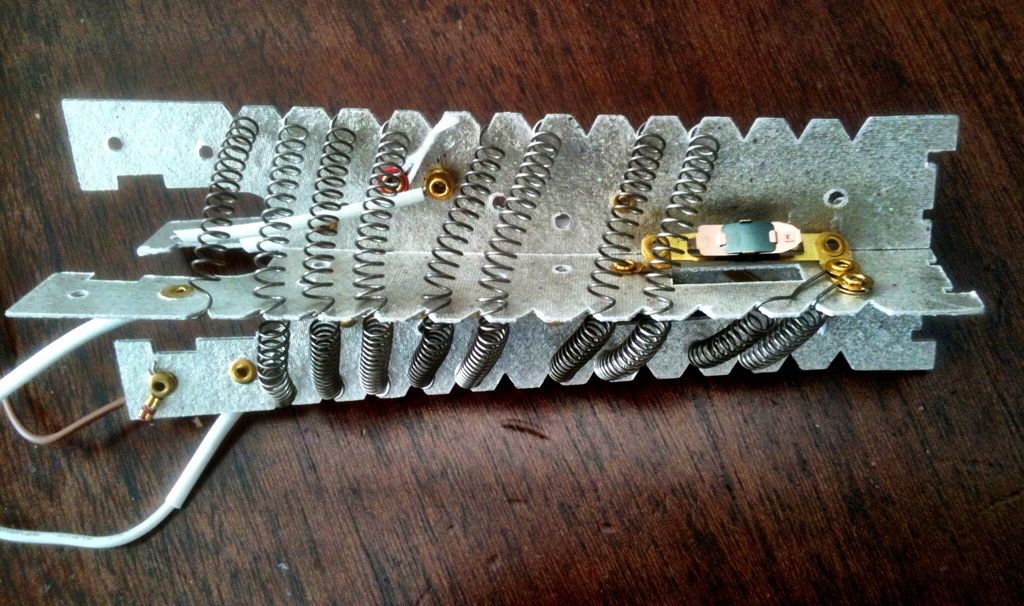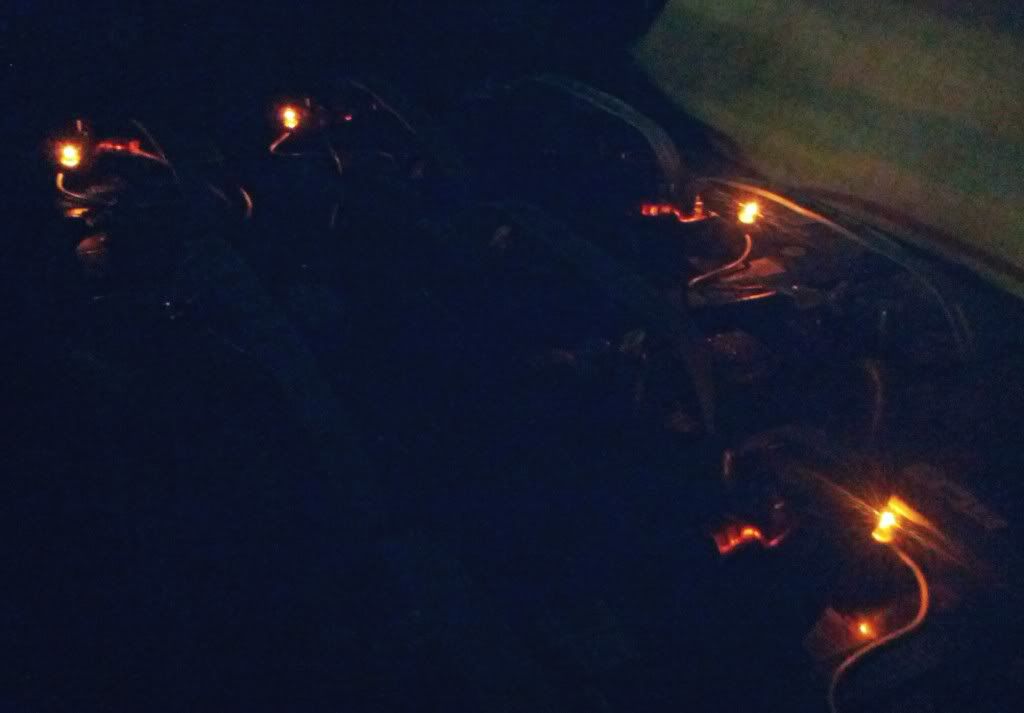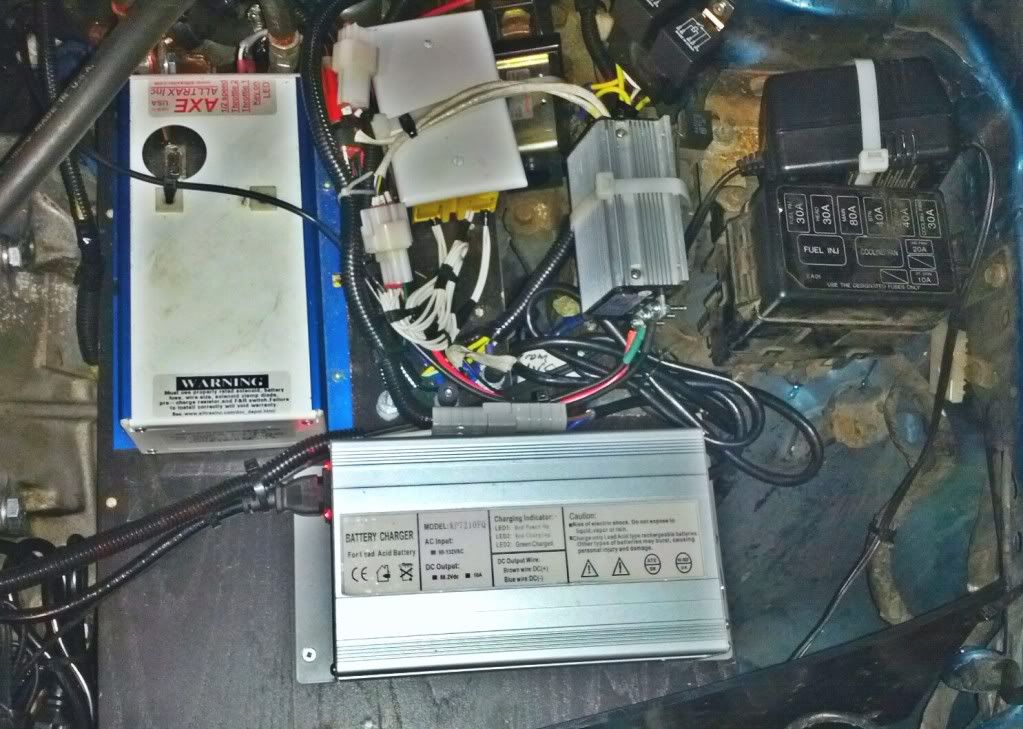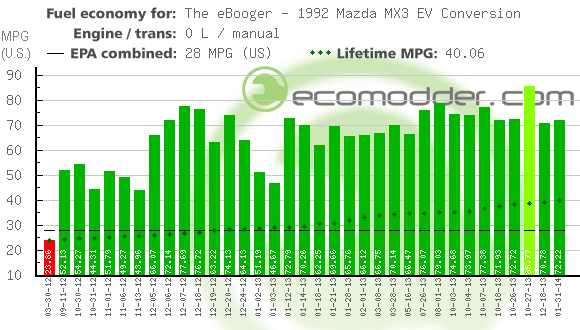 12-03-2012, 02:57 PM
12-03-2012, 02:57 PM
|
#91 (permalink)
|
|
Master EcoModder
Join Date: Jul 2008
Location: Langley, BC
Posts: 1,228
Fusion - '16 Ford Fusion Hybrid SE
Thanks: 190
Thanked 275 Times in 168 Posts
|
"Heater Weekend"
This weekend I was finally able to improve my heater, both in quantity of heat and reliability.
First off, I pulled my blow dryer heater coils out and found everything intact. Nothing burnt. Nothing funny. These coils draw about 7A at 75V, which is 525W. So what I did was remove two loops of coil to decrease the resistance.
Here is before:

Here is after:

For reliability, I now switch the coils on and off with my ex-field interrupt relay which is basically a Ford starter relay. This is instead of a regular old automotive 12V, 5-pin relay. Breaking high voltage DC current is quite difficult, and my old 5-pin relay basically had internal welding each and every time I turned the heater off because the contacts only open about 1mm apart. It is actually quite amazing that it lasted so long.
The results are good indeed. Now the heating coils draw 9A at 75V, which is 675W. A 28% improvement. Air coming out of the vents/defrost definitely feels warmer than it did before.
|
|
|

|
 Today Today
|
|
|
|
 Other popular topics in this forum...
Other popular topics in this forum...
|
|
|
|
 12-03-2012, 08:38 PM
12-03-2012, 08:38 PM
|
#92 (permalink)
|
|
Master EcoModder
Join Date: Nov 2008
Location: Massachusetts, USA
Posts: 442
Thanks: 1
Thanked 60 Times in 45 Posts
|
Heat is always good!
I have a 2.2 KW water heater in my EV and I find is does the job, but after 25-30 minutes it is HOT!
Have you have any snow to play with yet? We had our real first inch this past weekend and the heat came in real handy.
|
|
|

|
 12-04-2012, 04:21 AM
12-04-2012, 04:21 AM
|
#93 (permalink)
|
|
Master EcoModder
Join Date: Jul 2008
Location: Langley, BC
Posts: 1,228
Fusion - '16 Ford Fusion Hybrid SE
Thanks: 190
Thanked 275 Times in 168 Posts
|
I'm pretty jealous of your heater, that's for sure. Actually, I'm jealous of your entire Civic EV! Oh well. I keep telling myself this is just a practice round.
No snow here. We only get a few weeks of snow a year. It rains most of the winter. But I am looking forward to doing EV donuts, that's for sure!
|
|
|

|
 12-05-2012, 05:21 AM
12-05-2012, 05:21 AM
|
#94 (permalink)
|
|
Master EcoModder
Join Date: Jul 2008
Location: Langley, BC
Posts: 1,228
Fusion - '16 Ford Fusion Hybrid SE
Thanks: 190
Thanked 275 Times in 168 Posts
|
Lee Hart Battery Regulators
I am currently working on my six battery balancers so I don't cook my AGM batteries when I charge them. I am using a very simple, old design by Lee Hart, a very experienced EV guy who is prominent on the EVDL (Electric Vehicle Discussion List).
I won't bother trying to explain how they work; I will just give the link that explains it very well:
Lee Hart's Minimalist Battery Regulators
I am using a 6.2V and 6.8V zener diode in each regulator so they start shunting at 13.0V.
Here is my finished product:

Once these are finished I can install my Kelly charger. Then I should see a dramatic efficiency increase. |
|
|

|
|
The Following User Says Thank You to mechman600 For This Useful Post:
|
|
 12-05-2012, 09:21 PM
12-05-2012, 09:21 PM
|
#95 (permalink)
|
|
Master EcoModder
Join Date: Nov 2011
Location: slo county ca.
Posts: 277
Thanks: 24
Thanked 17 Times in 16 Posts
|
Nice, and simple
|
|
|

|
 12-07-2012, 06:26 PM
12-07-2012, 06:26 PM
|
#96 (permalink)
|
|
Master EcoModder
Join Date: Jul 2008
Location: Langley, BC
Posts: 1,228
Fusion - '16 Ford Fusion Hybrid SE
Thanks: 190
Thanked 275 Times in 168 Posts
|
A quick test of all my battery regulators with the original chargers showed that they all work properly. They start shunting a bit of current at 13.0V and by 13.7V they are just barely glowing. At 15.0V they are shining nice and bright.

I also installed my new Kelly charger. First off, I will say this charger performs just as it was designed to. Unfortunately, this is a big problem. Why? Because when I hastily ordered this charger, my pack was mostly flooded lead acid batteries. Now my pack is all AGM batteries, which requires a lower charging voltage.

This charger holds 88.2V (14.6V/battery) during the absorption charging stage which is proving to be too high. According to the battery specs, this is an okay voltage at the current temperature (10C), but it seems that with series charging, this voltage is making things go...well....wonky.
The bulk charge stage is fine. All voltages are even and slowly climb to 14.0V/battery and my regulators all start glowing nicely. But as soon as they go over 14.1V, a couple of batteries quickly shoot up to 15.2-15.5V (making my regulators glow very bright!) and after a while a couple of batteries go down to 13.8V. 15.5V is very bad for these particular AGMs because it can cause electrolyte bubbling at too high of a rate which may cause them to vent. Once AGMs vent, they quickly degrade because there is no way to fill them back up with electrolyte.
So...I have ordered another 7210 Kelly charger - this time with a constant voltage of 84.0V (14.0V/battery) and a float voltage of 81.0V (13.5V/battery). My current one shouldn't be difficult to sell because it has the correct charging profile to be able to charge lithiums.
Anyone in the market for a 72V/10A (88.2V max) charger?  |
|
|

|
 12-13-2012, 01:39 AM
12-13-2012, 01:39 AM
|
#97 (permalink)
|
|
Master EcoModder
Join Date: Jul 2008
Location: Langley, BC
Posts: 1,228
Fusion - '16 Ford Fusion Hybrid SE
Thanks: 190
Thanked 275 Times in 168 Posts
|
Despite the fact that my new charger needs constant babysitting, it has caused my economy to skyrocket by about 30% (now THERE'S a single ecomod for the record books!):

My last "fill" was a record 432Wh/mi. This sounds like a pile of horrible inefficiency (for an electric car), but allow me to defend my car for a second.
1. I charge at work and at home on either side of a tiny 4 mile commute. What I should be doing is only charging at work or at home because discharging the batteries deeper (with a longer charge) is much more efficient than multiple "top up" charges. This is because charging batteries is the most efficient during the bulk charge (when output current is max and pack voltage is still low). Efficiency drops during the later absorption charge (when max pack voltage is maintained and charging current is slowly dialed back until fully charged). What happens during absorption stage is that a lot of energy is wasted as heat/electrolyte bubbling in the batteries.
2. Cold weather is taking its toll on battery efficiency in general. It has been 2-8C the last couple of weeks.
3. My heater has been turned on most of the time. That's 675 watts of constant battery draw just to keep me cozy. |
|
|

|
 12-13-2012, 12:05 PM
12-13-2012, 12:05 PM
|
#98 (permalink)
|
|
EV test pilot
Join Date: Jan 2008
Location: Oconomowoc, WI, USA
Posts: 4,435
Thanks: 17
Thanked 663 Times in 388 Posts
|
Since you can charge at home or work, you may want to just pre-heat your car. It makes it real comfy to hop in a warm car on a cold day.
I use an oil-filled 1500 watt electric radiator on a timer. That will hold enough heat in the thermal mass for a 4 mile trip too.
I also built a heated coat for about $5, and got a heated steering wheel cover. ($20 brand new at the store, or $5 brand new at the THRIFT store.)
Doing something like that would give you luxury heat, and you wouldn't need to run the 600 watt heater from the batteries, but you would always have it to fall back on.
I LIKE the neat tricks you can do with EVs, like running the heat before otherwise having the car on in a closed up garage. Don't try that one with a gasser! |
|
|

|
 12-13-2012, 12:24 PM
12-13-2012, 12:24 PM
|
#99 (permalink)
|
|
Administrator
Join Date: Dec 2007
Location: Germantown, WI
Posts: 11,203
Thanks: 2,501
Thanked 2,589 Times in 1,555 Posts
|
Since you can charge at work and at home, perhaps you can stop after the bulk charge is done? Your cells should be above sulfation voltage (I think) and you would extend the battery life and increase efficiency.
|
|
|

|
 12-13-2012, 01:42 PM
12-13-2012, 01:42 PM
|
#100 (permalink)
|
|
Master EcoModder
Join Date: Jul 2008
Location: Langley, BC
Posts: 1,228
Fusion - '16 Ford Fusion Hybrid SE
Thanks: 190
Thanked 275 Times in 168 Posts
|
Quote:
Originally Posted by bennelson

Since you can charge at home or work, you may want to just pre-heat your car. It makes it real comfy to hop in a warm car on a cold day.
I use an oil-filled 1500 watt electric radiator on a timer. That will hold enough heat in the thermal mass for a 4 mile trip too.
I also built a heated coat for about $5, and got a heated steering wheel cover. ($20 brand new at the store, or $5 brand new at the THRIFT store.)
Doing something like that would give you luxury heat, and you wouldn't need to run the 600 watt heater from the batteries, but you would always have it to fall back on.
I LIKE the neat tricks you can do with EVs, like running the heat before otherwise having the car on in a closed up garage. Don't try that one with a gasser! |
I do preheat with a 1500 watt electric heater on a timer. It is set to heat for half an hour before I leave for work. It is hilarious watching everyone scrape their windows while I drive off in my defrosted ELECTRIC car! But I think your oil-filled heater (with heat retention) is a much better option.
What I could do it split my heater coils in half for a low/high option, but I don't feel like it right now. I could also get a heated seat cover and only turn the car heat on to defrost when necessary. Doing this just for the kWh/mi numbers seems a bit silly though. It's really not that cold here on the coast - usually above freezing. It's more the 100% humidity that keeps fogging up my windshield that is annoying!
Quote:
Originally Posted by Daox

Since you can charge at work and at home, perhaps you can stop after the bulk charge is done? Your cells should be above sulfation voltage (I think) and you would extend the battery life and increase efficiency.
|
I stopped charging the last time once voltages started shooting above 14.2V or so which is why my last efficiency was so high.
I don't think AGMs suffer from sulfation (when leaving them discharged) the way floodies do, do they?
Once my 84.0V Kelly 7210 arrives I am hoping that the absorption stage will be much shorter - like 5 minutes or so. It will maintain 14.0V/battery and pull back current slowly to maintain this voltage, down to 2A when it switches to float (81.0V). But I will check efficiency after only charging once per commute next week when I am back from vacation.
I am also figuring out what to do with my accessory battery. Now that my battery pack charging happens so quickly, my junky trickle charger doesn't keep up. I have a spare 18.5V 75W laptop charger that I might hook up to it just so see what happens. Hmmmm.
Last edited by mechman600; 12-13-2012 at 01:54 PM..
|
|
|

|
|